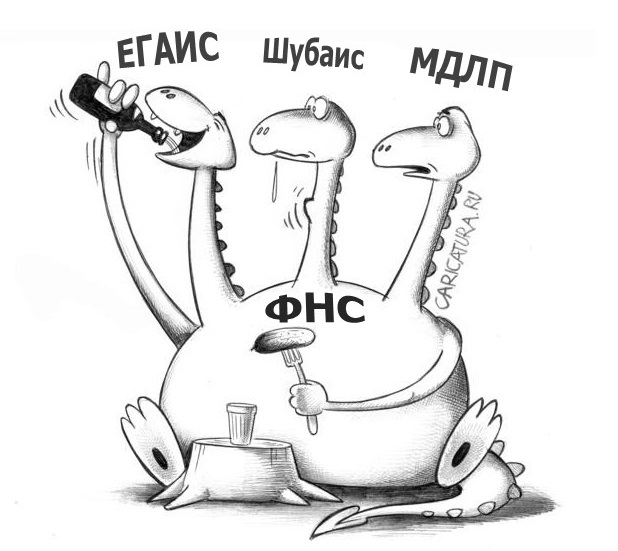Automatic accrual of fines according to the Unified State Automated Information System: fiction or reality?
On April 26, 2018, thousands of EGAIS users selling beer received a letter with the same content through the personal account of the system: “Information message on the accounting of unmarked product residues in the EGAIS”. The essence of this long message was reduced to one sentence: on the basis of the declaration company of the 1st quarter of 2018, it was revealed that your organization recorded remnants of unmarked alcoholic beverages (beer, beer drinks, cider, poire and mead) as of 01/04/2018 in inappropriate amounts data volume declarations. According to the EGAIS system, the remainder of the products is - (X) gave, according to the volume declarations - (Y) gave, the difference is - (XY) gave.
Further quite simple: “Rosalkogolregulirovanie notes that these discrepancies may indicate a violation of the procedure for accounting or declaration. This violation provides for penalties in accordance with the Code of Administrative Offenses ... ... We note that upon the expiration of the period for submitting corrective declarations for the 1st quarter of 2018, all existing discrepancies will be sent to the control subjects in the constituent entities of the Russian Federation. Rosalkogolregulirovanie will continue to conduct similar reconciliations . "

')
This message, received on April 26, on Thursday, and even before the long May holidays, did not improve the mood. Moreover, it is not at all clear from him what needs to be done in order not to get the very fine according to Code of Administrative Offenses 14.17.1, which is from 100 to 150 thousand rubles. Because experienced market players are well aware that the sales data in the declaration and in the Unified State Automated Information System should be entered according to different algorithms and can completely coincide only by a miracle.
A slight panic in the alcohol market reigned until May 3, when it became clear:
1. The FSRAR sent out such a letter to all those who have a difference between the data on the declaration and on the EGAIS amounted to more than 100 liters of unlabelled alcohol. These 100 liters are left for error due to different methods of registering sales.
2. According to the data of the first quarter, no one will be fined and the second quarter will be used to restore order. But the differences in the balances according to the data of the second quarter will immediately turn into fines.
A slight panic gave way to deaf longing.
FSRAR managed to combine the data of two different state alcohol accounting systems (declarations and ) and he did it only in order to identify those who do not write off the sale of unlabelled alcohol in the EGAIS or do it incorrectly. The mechanism of declaring sales of alcohol has been working for several years, everyone is used to it. In addition, it has internal algorithms for cross-cutting verification of the data provided between wholesalers and retailers, so you can submit the “left” data only if you agree with the whole chain of your suppliers, which is unlikely. But the data in the Unified State Automated Information System previously had nothing to check with. How to understand how the data that is reflected in the system are correct? Do you have such a large supply of alcohol, or you simply do not write it off? We are talking about unmarked alcohol, which cannot be scanned at the checkout counter - draft beer, cider, mead. This kind of alcohol is written off manually on a daily basis following the results of sales, but not all of them do it.
For us, this “special operation” of the FSRAR has become another example of the movement of state bodies to a system of fully automatic control over entrepreneurs. There are more and more various marking systems, electronic reporting and fiscal documents. And along with them, the mechanisms of work with those “big data” that they accumulate appear. Regarding retail trade, the next step to such a global control system was Federal Law No. 487-FZ of December 31, 2017, which comes into force on January 1, 1919 and allows you to supplement the cash voucher with a new mandatory “product code”. This requisite will allow you to identify a marked product or product line. In addition to the Government Decree No. 792-p dated April 28, 2018, which determines the list of goods subject to mandatory labeling by means of identification and also coming into force on January 1, 19, it becomes clear that it will be very difficult to evade fiscal supervision. The control will be dual - both from the operator of the labeling and from the FTS with its huge base of fiscal checks.

Such a move on the part of the state allows us to solve the complex technological problem associated with that zoo of "egazy", "shubais", "pharmacy agaisa" and various other "... Isa" created by various departments in recent years. Now we have several global operators of federal state information systems (FGIS) and each with its own “big data” in its original formats. The unique identifier of the product to be marked (alcohol bottles, fur coats, cigarette packs, medicine packages, sneakers, diamond rings, etc.) will be recorded in the cash voucher and sent to the CRF along with registration in the native FGIS. Thus, the global database of fiscal documents will unite departmental "egazy" a cut-through accounting unit. Imagine about the analytical possibilities of such a system can be infinite.

The increase in the collection of various taxes, excises and fees has become a universal answer to all economic issues in our country. One can argue with this, disagree, invent new schemes for bypassing control systems or go completely into the shadows. So far, it seems that the government is assembling some kind of global analytical system for tax administration. Life will be more accurate fun!
Further quite simple: “Rosalkogolregulirovanie notes that these discrepancies may indicate a violation of the procedure for accounting or declaration. This violation provides for penalties in accordance with the Code of Administrative Offenses ... ... We note that upon the expiration of the period for submitting corrective declarations for the 1st quarter of 2018, all existing discrepancies will be sent to the control subjects in the constituent entities of the Russian Federation. Rosalkogolregulirovanie will continue to conduct similar reconciliations . "

')
This message, received on April 26, on Thursday, and even before the long May holidays, did not improve the mood. Moreover, it is not at all clear from him what needs to be done in order not to get the very fine according to Code of Administrative Offenses 14.17.1, which is from 100 to 150 thousand rubles. Because experienced market players are well aware that the sales data in the declaration and in the Unified State Automated Information System should be entered according to different algorithms and can completely coincide only by a miracle.
A slight panic in the alcohol market reigned until May 3, when it became clear:
1. The FSRAR sent out such a letter to all those who have a difference between the data on the declaration and on the EGAIS amounted to more than 100 liters of unlabelled alcohol. These 100 liters are left for error due to different methods of registering sales.
2. According to the data of the first quarter, no one will be fined and the second quarter will be used to restore order. But the differences in the balances according to the data of the second quarter will immediately turn into fines.
A slight panic gave way to deaf longing.
FSRAR managed to combine the data of two different state alcohol accounting systems (declarations and ) and he did it only in order to identify those who do not write off the sale of unlabelled alcohol in the EGAIS or do it incorrectly. The mechanism of declaring sales of alcohol has been working for several years, everyone is used to it. In addition, it has internal algorithms for cross-cutting verification of the data provided between wholesalers and retailers, so you can submit the “left” data only if you agree with the whole chain of your suppliers, which is unlikely. But the data in the Unified State Automated Information System previously had nothing to check with. How to understand how the data that is reflected in the system are correct? Do you have such a large supply of alcohol, or you simply do not write it off? We are talking about unmarked alcohol, which cannot be scanned at the checkout counter - draft beer, cider, mead. This kind of alcohol is written off manually on a daily basis following the results of sales, but not all of them do it.
For us, this “special operation” of the FSRAR has become another example of the movement of state bodies to a system of fully automatic control over entrepreneurs. There are more and more various marking systems, electronic reporting and fiscal documents. And along with them, the mechanisms of work with those “big data” that they accumulate appear. Regarding retail trade, the next step to such a global control system was Federal Law No. 487-FZ of December 31, 2017, which comes into force on January 1, 1919 and allows you to supplement the cash voucher with a new mandatory “product code”. This requisite will allow you to identify a marked product or product line. In addition to the Government Decree No. 792-p dated April 28, 2018, which determines the list of goods subject to mandatory labeling by means of identification and also coming into force on January 1, 19, it becomes clear that it will be very difficult to evade fiscal supervision. The control will be dual - both from the operator of the labeling and from the FTS with its huge base of fiscal checks.

Such a move on the part of the state allows us to solve the complex technological problem associated with that zoo of "egazy", "shubais", "pharmacy agaisa" and various other "... Isa" created by various departments in recent years. Now we have several global operators of federal state information systems (FGIS) and each with its own “big data” in its original formats. The unique identifier of the product to be marked (alcohol bottles, fur coats, cigarette packs, medicine packages, sneakers, diamond rings, etc.) will be recorded in the cash voucher and sent to the CRF along with registration in the native FGIS. Thus, the global database of fiscal documents will unite departmental "egazy" a cut-through accounting unit. Imagine about the analytical possibilities of such a system can be infinite.

The increase in the collection of various taxes, excises and fees has become a universal answer to all economic issues in our country. One can argue with this, disagree, invent new schemes for bypassing control systems or go completely into the shadows. So far, it seems that the government is assembling some kind of global analytical system for tax administration. Life will be more accurate fun!
Source: https://habr.com/ru/post/358994/
All Articles